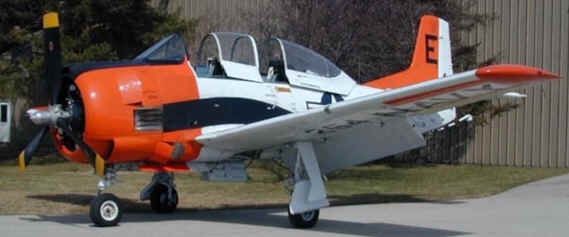

(Similar type as in story.)
A Trojan Horse - #8 of 10
He was almost begging – "Please! Oh, please! Come fly with me! Saturday? Sunday? Or any weekday evening? This week?! How about next week?"
This is just a short little story about a guy, Hugh, who thought he was getting a good deal on a nice airplane. It was a high-performance airplane – a T-28B Trojan. It was a Naval advance trainer. It had a big radial engine, tricycle retracting landing gear, and two-place tandem seating. The student sat in the front; the instructor in the back. It was a
big, rugged plane that had a tail hook and was flown on carriers for student training.There were modified versions that flew air-combat in Vietnam and various other places for other air forces. It could carry bombs, rockets, gun pods, etc.
He had all sorts of ideas when he got a chance to buy it with the owner doing the financing.
He sold a good pickup that he had used for work, and he sold his nice, like-new personal car (he was not married), and he got all the cash he could for the installment on the down payment. He had inherited a little business which he also sold.
I was never told the complete story, but Hugh said that he could sell enough rides in a military aircraft to pay for the plane.
Yes, he knew that he had to keep working and that would cut down on the time he could be "hauling customers."
He was overwhelmed by the opportunity to buy such a plane and he was also very unrealistic.
Soon he was offering to take anyone to the airport to see his plane. I went.
It was big.
I saw that big radial engine and all I could think of was the amount of smoke that came billowing out of such engines when they were started.
It had a 1,400 hp, 9-cylinder engine with a two-speed supercharger and tuned exhaust. The engine alone weighed 1,000 pounds. It was near the size of the largest fighter to fly in WWII – the P-47 Thunderbolt.
With radial engines, oil collects in the lower cylinders and before starting, the prop has to be hand-pulled through a few revolutions so the oil can run out of the lower cylinders through the exhaust valves. Then when it starts, it has to burn all that oil out of the lower cylinders plus the exhaust headers and collectors.
Oil costs money.
And aviation fuel costs money. He learned that it cost a whole lot of money...and that plane needed a bigger hanger than a smaller plane...and there was all the maintenance required and corrosion inspections, and...
Within a couple of months, he had figured out that he was going to lose the plane back to the owner, but first, he was really going to enjoy it.
He would give a ride to anyone who would just pay for the fuel.
This might seem like a good deal, but in an hour, that big engine burned 50 gallons of high-test aviation fuel.
And the pilot had to have 50 hours in the plane to be type-rated. This alone pretty much broke the new owner. So to be certified to fly the plane, 2,500 gallons went through the engine. These are the things he should have checked before buying the plane.
To start engine, warm up, taxi to runway, take off, fly the pattern and come right back and land, then taxi to the hangar would take about a 55-gallon drum of aviation fuel.
After about eight months, Hugh said he was lucky to turn the plane back to such an agreeable previous owner. It turned out that a lot of people had "bought" that airplane...only to learn the truth of the expenses. The guy was making money on it by selling it over and over.
I never flew in it. And I never knew where the plane ended up.
But it sure was pretty and it made a lot of exciting noise while burning up aviation fuel.
Ken Cashion